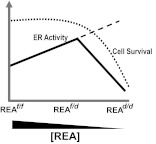Fig. 7.
Model for the relationship between REA gene dosage and ER activity and optimal uterine function and fertility. Estrogen activity in the uterus was enhanced with reduction of REA level in REAf/d mice, thereby allowing reduced repression of E2-driven ER activity, resulting in an increased uterine weight gain and enhanced cell proliferation and gene expression with E2 treatment. However, further depletion of REA (REAd/d mice) does not elicit a further enhancement of E2 stimulation (long dashes), because this is associated with loss of an essential cell survival function of REA that results in cell cycle arrest and apoptosis, leading to the impairment of REA-dependent activities essential for ER action, and uterine development and function. Thus, the normal gene dosage of REA is required for optimal fertility, with hyperresponsiveness to E2 in REAf/d mice and underresponsiveness to hormone in REAd/d mice resulting in subfertility or infertility, respectively.

